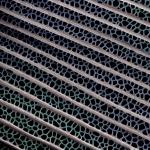
Polymeric membranes are widely used in water treatment to remove pathogens, particles and organics from surface, ground, process and filter backwash water. However, ceramic membranes are currently only used for these purposes in Japan. Because ceramic membranes are much more resilient under extreme conditions (e.g. temperature, pH and chemicals), they facilitate a more rigorous cleaning, resulting in a better overall filtration performance than that of polymeric membranes. DEMEAU will stimulate the application of ceramic membranes by addressing the following aspects:
TECHNEAU and other projects showed that hybrid processes with ceramic membranes (HCMS) – combinations of ceramic membranes with processes such as in-line coagulation, activated carbon or ion exchange – are promising cost-effective candidates for many tasks in future water treatment schemes. Therefore, DEMEAU investigates the feasibility of HCMS for the improvement of water quality (e.g. biological stability and removal of emerging pollutants). In addition, HCMS will be compared to state of-the-art treatment systems and demonstrated on a pilot-scale.
The cost-efficiency of ceramic membranes has been dramatically improved in a recent innovative module known as Ceramac®, which was design by the Watercompany of North Holland PWN in cooperation with RWB. Essential in this design is the largely-increased number of membranes in the pressure vessel, which substantially decreases investment costs. To enable the production of Ceramac® at the full-scale level, further innovations in the reactor design are needed. DEMEAU will develop and test these reactor design innovations at the pilot-scale level and subsequently implement them full-scale.
DEMEAU will also evaluate the potential of NanoParticles Analyser, based on Laser-Induced Breakdown Detection (NPA/LIBD) technology, to i) monitor ultrafiltration (UF) performance in terms of nanoparticle removal (20–30 nm up to 1 Pm) and ii) control in-line real time membrane integrity during drinking water treatment. The LIBD technology is an alternative tool to current membrane integrity monitoring technologies that requre the system to be off-line (e.g. pressure decay test, turbidity monitoring and diffuse air flow).
In addition, cost-efficiency of the ceramic membrane systems could simply be improved by process optimization. The easiest way to optimize a process is to use an intelligent control system that automatically adjusts optimal process parameters, depending on raw water characteristics and the foregoing fouling behaviour of the membrane system. Due to the process complexity and the multidimensional parameter matrix in ceramic membrane filtration, promising control systems, such as ANCS, are based on an artificial neural net (ANN). The application of ANN offers advantages including process simulation and online parameter prediction. However, ANN was not used for automatic process control of technical scale membrane systems, resulting in a worldwide unique application investigated by DEMEAU.
